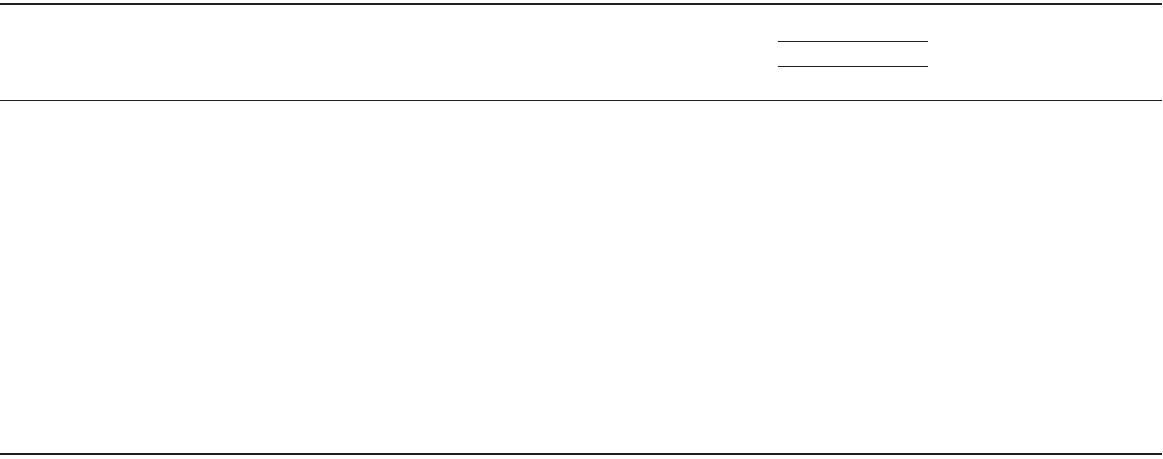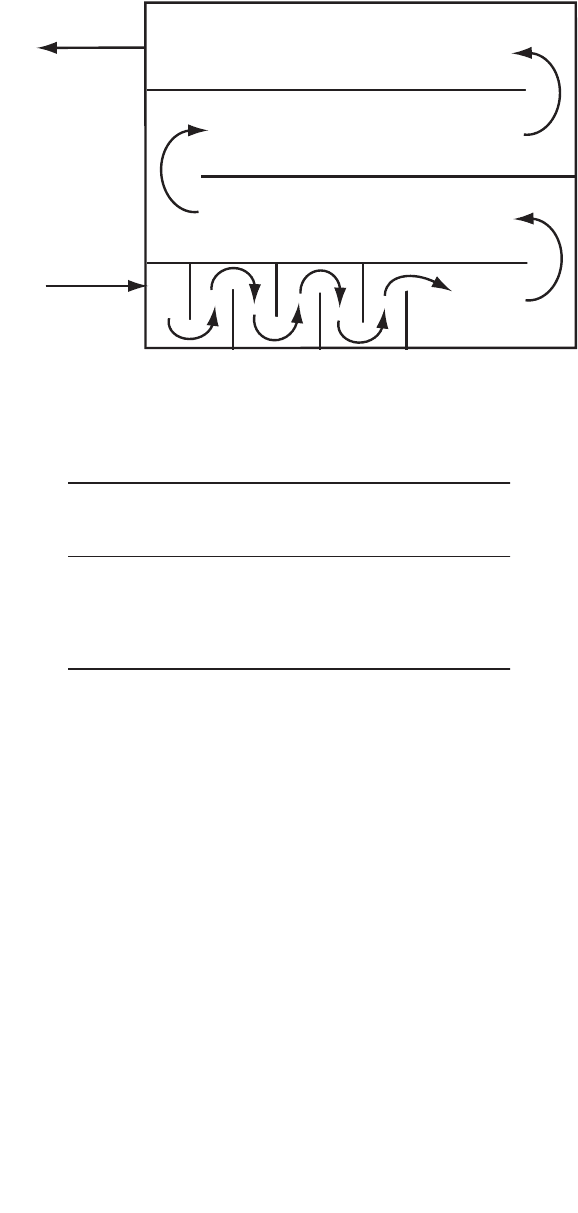Wai-Fah Chen.The Civil Engineering Handbook
Подождите немного. Документ загружается.


11-12 The Civil Engineering Handbook, Second Edition
Mixing and flocculation also affect the apparent K
s
value. This was first demonstrated theoretically by
Powell (1967) and then empirically by Baillod and Boyle (1970).
Wastewater treatment plants are operated to produce low soluble substrate concentrations, and the
correlation between soluble substrate and q
a
can be approximated as a straight line (called “first-order”
kinetics):
(11.36)
where k = the first-order rate constant (m
3
/kg VSS·s).
In pure cultures grown on minimal media, Eq. (11.36) is observed whenever S
s
is much smaller than
K
s
, and k is approximately q
max
/K
s
. However, in activated sludge plants treating complex wastes, individual
pure substances are removed at zero-order kinetics (S
s
K
s
; q ª q
max
) down to very low concentrations.
Individual substances are removed at different constant rates, and in batch cultures tend to disappear
sequentially (Wuhrmann, 1956; Tischler and Eckenfelder, 1969; Gaudy, Komolrit, and Bhatia, 1963). If
a lumped variable like COD is used to measure soluble organic matter, the overall pattern fits Eq. (11.36).
Biokinetic Caveat
From the discussion on the Effect of Tank Configuration on Removal Efficiency in Chapter 9, Section 9.2,
it might be assumed that organic matter removal in plug flow aeration tanks and sequencing batch
reactors would be greater than that in mixed-cells-in-series, which, in turn, would be more efficient than
completely mixed reactors. Unfortunately, this is not true. In the case of mixed microbial populations
consuming synthetic or natural wastewater, the effluent soluble organic matter concentration is not
affected by reactor configuration (Badger, Robinson, and Kiff, 1975; Chudoba, Strakova, and Kondo,
1991; Haseltine, 1961; Kroiss and Ruider, 1977; Toerber, Paulson, and Smith, 1974). This is true regardless
of how the organic matter is measured: biochemical oxygen demand, chemical oxygen demand, or total
organic carbon. The appropriate design procedure is to assume that all reactors are completely mixed,
regardless of any internal baffling.
Biological processes do not violate the laws of reaction kinetics. Instead, it is the simplistic application
of these laws that is at fault. The soluble organic matter concentration in the effluents of biological
reactors is not residual substrate (i.e., a reactant). Rather, it is a microbial product (Baskir and Spearing,
1980; Erickson, 1980; Grady, Harlow and Riesing, 1972; Hao and Lau, 1988; Rickert and Hunter, 1971).
It should not be assumed that reactor configuration has no effect. Sequencing batch reactors and
mixed-cells-in-series reactors with short compartmental detention times (less than 10 min) suppress
activated sludge filamentous bulking and are the preferred configuration for that reason.
Furthermore, in the case of particulate or emulsified substrates, ideal plug flow configurations, like SBRs,
produce lower effluent substrate concentrations than do CSTRs (Cassidy, Efendiev, and White, 2000).
Return Sludge Flow Rate
The return sludge flow rate can be calculated using the Benefield–Randall (1977) formula:
(11.37)
where Q = the settled sewage flow rate (m
3
/s)
Q
r
= the return activated sludge (RAS) flow rate (m
3
/s)
V = the aeration tank volume (m
3
)
X = the concentration of volatile suspended solids in the aeration tank mixed liquor, MLVSS
(kg VSS/m
3
)
X
r
= the concentration of volatile suspended solids in the return (or recycle) activated sludge
(kg VSS/m
3
)
qkS
as
=
Q
Q
X
X
X
X
rX
rr
=
-
-
ª
-
1
1
1
1
t
Q
© 2003 by CRC Press LLC

Biological Wastewater Treatment Processes 11-13
Q
X
= the solids’ retention time (s)
t = the hydraulic retention time, V/Q (s)
This is another rearrangement of the clarifier solids balance, Eq. (11.1).
Steady State Oxygen Consumption
The steady state total oxygen demand balance on the whole system applicable to any activated sludge
process is as follows:
(11.38)
where C
so
= the influent soluble plus particulate substrate concentration (kg COD/m
3
)
C
TKNo
= the influent soluble plus particulate total kjeldahl nitrogen (TKN) concentration (kg N/m
3
)
Q = the settled or raw sewage flow rate (m
3
/s)
R
N
2
= the nitrogen gas production rate (kg N
2
/s)
R
O
2
= the oxygen utilization rate (kg O
2
/s)
S
se
= the final effluent soluble organic matter concentration (kg COD/m
3
)
S
TKNe
= the final effluent soluble TKN concentration (kg N/m
3
)
V = the aeration tank volume (m
3
)
X
v
= the volatile suspended solids concentration in the aeration tank (kg VSS/m
3
)
Q
X
= the solids’ retention time (s)
4.57 = the oxygen demand of the TKN for the conversion of TKN to HNO
3
(kg O
2
/kg TKN)
2.86 = the oxygen demand of nitrogen gas for the conversion of nitrogen gas to HNO
3
(kg O
2
/kg
N
2
)
1.98 = the oxygen demand of the VSS, assuming complete oxidation to CO
2
, H
2
O, and HNO
3
(kg O
2
/kg VSS)
Some authors mistakenly use 1.42 as the oxygen demand of the biomass, but this ignores the oxygen
demand of the reduced nitrogen in the biomass solids.
If there is no denitrification, the term for nitrogen gas production, R
N
2
, is zero. In municipal waste-
waters, there is no denitrification unless there is first nitrification, because all influent nitrogen is in the
reduced forms of ammonia or organically bound nitrogen. However, some industrial wastewaters (prin-
cipally explosives and some agricultural chemicals) contain significant amounts of nitrates.
If there is no nitrification, the influent TKN is merely redistributed between the soluble TKN output,
QS
TKNe
, and the nitrogen incorporated into the waste solids, VX/Q
X
. The oxygen demand of the nitrogen
in the waste solids exactly cancels the oxygen demand of the TKN removed. In the case of the input-
output variables, the oxygen utilization rate becomes,
(11.39)
(11.40)
where 1.42 = the oxygen demand of the VSS assuming oxidation to CO
2
, H
2
O, and NH
3
(kg O
2
/kg VSS).
In the case of the Gram–Pearson–McKinney–Pirt model, the oxygen uptake rate in the aeration tank
would be as follows:
(11.41)
RQCS QC S R
VX
so se o e
v
X
O TKN TKN N
2
=-
()
+-
()
--457 286 198
2
...
Q
RQCS
VX
so se
v
X
O
2
=-
()
-142.
Q
RYQCS
vo so seO
2
=-
()
-
()
1142.
oxygen uptake substrate oxidized biomass oxidized maintenance
O
2
=++
=-
Ê
Ë
Á
ˆ
¯
˜
+-
()
+R
Y
VX f k VX k VX
ca
ca d d ca mc ca
1
11m
© 2003 by CRC Press LLC

11-14 The Civil Engineering Handbook, Second Edition
where k
mc
= the maintenance energy demand as COD of substrate per COD of biomass (kg COD/kg COD s)
X
ca
= the active biomass concentration in the aeration tank as COD rather than VSS (kg COD/m
3
)
Y
ca
= the true growth yield of the active biomass as COD on the substrate COD (kg COD/kg COD)
Substitution from Eqs. (11.3), (11.4), (11.5), and (11.10) produces,
(11.42)
And, if the inert influent organic solids are added [Eq. (11.6)], one gets again Eq. (11.36) (with all the
particulate organics reported as COD):
(11.43)
Minimum Oxygen Concentration
The rate of carbonaceous BOD
5
removal is reduced at oxygen concentrations below about 0.5 mg/L
(Orford, Heukelekian, and Isenberg, 1963). However, most authorities require higher aeration tank DOs.
For nonnitrifying systems, the Joint Task Force (1988) recommends a DO of 2 mg/L under average
conditions and 0.5 mg/L during peak loads. The Wastewater Committee (1997) and the Technical
Advisory Board (1980) require a minimum DO of 2 mg/L at all times.
Temperature
Field and laboratory data indicate that the BOD
5
removal efficiency increases from about 80–85% to
90–95% as the temperature increases from about 5 to 30°C (Benedict and Carlson, 1973; Hunter,
Genetelli, and Gilwood, 1966; Keefer, 1962; Ludzack, Schaffer, and Ettinger, 1961; Sawyer, 1942; Sayigh
and Malina, 1978). Increases above 30°C do not improve BOD
5
removal efficiency, and increases above
45°C degrade BOD removal efficiency (Hunter, Genetelli, and Gilwood, 1966).
The true growth yield coefficient, Y, does not vary with temperature.
The values of k
d
and k
m
are so uncertain that temperature adjustments may not be warranted; however,
most engineers make temperature corrections to k
d
. This is justified by the reduction in predation and
consequent increase in solids’ production that occurs at low temperatures (Ludzack, Schaffer, and
Ettinger, 1961). Low-temperature operation also results in poorer flocculation and a greater amount of
dispersed fine solids. This is also due to reduced predation. The temperature correction to the decay rate
would be as follows (Grady, Daigger, and Lim, 1999; Joint Task Force, 1992):
(11.44)
The parameters of the Monod function vary with temperature approximately as follows (Novak, 1974;
Giona et al., 1979):
(11.45)
(11.46)
RQXSS
VX X X
cso cso cs
ca cd cs
X
O
2
=+-
()
-
++
()
Q
RQXXSS
VX X X X
QC S
VX
cio cso cso cs
ca cd cs ci
X
co cs
c
X
O
2
=++-
()
-
+++
()
=-
()
-
Q
Q
kT
kT
d
do
TT
o
1
104
1
()
()
=
-
.
m
m
max
max
max
max
()
.
T
T
qT
qT
oo
TT
o
1
1
110
1
()
=
()
()
@
-
KT
KT
s
so
TT
o
1
1 075
1
()
()
@
-
.
© 2003 by CRC Press LLC

Biological Wastewater Treatment Processes 11-15
Lin and Heinke (1977) analyzed 26 years of data from each of 13 municipal plants and concluded that
the temperature dependence of the first-order rate coefficient was,
(11.47)
pH
The optimum pH for the activated sludge process lies between 7 and 7.5, but pH does not substantially
affect BOD
5
removal between about 6 and 9 (Keefer and Meisel, 1951). BOD
5
removal falls sharply outside
that range and is reduced by about 50% at pHs of 5 or 10.
Nutrients
Most municipal and many industrial wastewaters have a proper balance of nutrients for biological waste
treatment. However, some industrial wastes may be deficient in one or more required elements. The
traditional rule of thumb is that the BOD
5
:N and BOD
5
:P mass ratios should be less than 20:1 and 100:1,
respectively (Helmers et al., 1951). Sludge yields and treatment efficiencies fall when the BOD
5
:P ratio
exceeds about 220 (Greenberg, Klein, and Kaufman, 1955; Verstraete and Vissers, 1980).
Some industrial wastes are deficient in metals, especially potassium. Table 11.2 is the approximate
composition of bacterial cells, and it may be used as a guide to nutrient requirements.
Waste-activated sludge is typically about 70% volatile solids, and the volatile solids contain about
7% N and 3% P. (See Table 11.3.)
Poisons
Carbonaceous BOD
5
removal is not affected by salinity up to that of seawater (Stewart, Ludwig, and
Kearns, 1962). Approximate concentrations at which some poisons become inhibitory are indicated in
Tables 11.4 and 11.5.
Traditional Rules of Thumb
Nowadays, most regulatory authorities have approved certain rules of thumb. An example is shown in
Table 11.6 (Wastewater Committee, 1997). The rules of thumb should be used in the absence of pilot-
plant data or when the data are suspect.
Carbonaceous BOD Removal
Solids’ Retention Time
The solids’ retention time should be short enough to suppress nitrification but long enough to achieve
essentially complete soluble CBOD removal. At 25°C, a solids’ retention time of 1 to 2 days suffices for nearly
complete soluble BOD
5
removal, but 5 days SRT will be needed at 15°C. Satisfactory flocculation may require
3 days SRT, and the hydrolysis of particulate BOD
5
may require 4 days SRT (Grady, Daigger, and Lim, 1999).
If conditions are otherwise favorable, nitrification can occur at SRTS less than 3 days at warmer temper-
atures. Under these circumstances, aeration tank dissolved oxygen concentrations less than 2 mg/L may
partially inhibit nitrification (Mohlman, 1938), but the aeration tank DO should not be so small as to limit
soluble BOD
5
uptake and metabolism. Regulators often specify an absolute minimum DO of 1 mg/L.
It should be noted that ammonia is toxic to fish at concentrations around 1 mg/L (Table 8.7), and in
many cases, the regulatory authority will require nitrification to prevent fish kills. Nonnitrifying processes
are acceptable only where the receiving water provides dilution sufficient to avoid toxicity.
System Biomass and Waste Solids Production
Once the SRT is determined, the system biomass and waste solids production rate may be calculated.
If pilot-plant data are available, the SRT determines the specific uptake rate and food-to-microorgan-
ism ratio via Eqs. (11.31) and (11.32). The definitions of q
v
and F
v
directly produce the required MLVSS,
kT
kT
o
TT
o
1
1 125
1
()
()
@
-
.
© 2003 by CRC Press LLC

11-16 The Civil Engineering Handbook, Second Edition
VX
v
. Furthermore, the assumption of perfect clarification (X
e
= 0) produces an upper limit on the waste
sludge production rate, Q
w
X
w
, via the definition of the SRT, Eq. (11.2).
If a calibrated model is available, the MLVSS can be calculated from Eq. (11.9) with substitutions from
Eqs. (11.4), (11.5), (11.6), and (11.10):
(11.48)
Except for particulate substrate, the solids terms on the right-hand side must have units of VSS. In
the case of particulate substrate, in its first appearance (in parentheses), it must have the units appropriate
TABLE 11.2 Approximate Composition of Growing Bacteria and Nutrient
Requirements for Biological Treatment
We ight Percentage
1,2,3
Component Total Weight Dry Weight Mole Ratio
Eckenfelder’s Guidelines
4
(mg substance/kg BOD)
Water 80 — — —
Solids 20 100 — —
Ash — 7 — —
Volatile Solids — 93 — —
C—546.5 —
O—232.1 —
N—9.6 1.0
a
H—7.4 10.7 —
P—30.14
b
K—10.04 4500
Mg — 0.7 0.04 3000
Na — 0.5 0.03 50
S—0.5 0.02 —
Ca — 0.5 0.02 6200
Fe — 0.025 — 12,000
Cu — 0.004 — 146
Mn — 0.004 — 100
Co — — — 130
CO
3
——— 2700
Mo — — — 430
Se — — — 0.0014
Zn — — — 160
Proteins — 50 — —
RNA — 20 — —
Carbohydrates — 10 — —
Lipids — 7 — —
DNA — 3 — —
Inorganic ions — 3 — —
Small molecules — 3 — —
a
N(kg/d) = [0.123·f + 0.07.(0.77 – f)]·DMLVSS(kg/d)/0.77, where f = the biodegradable
fraction of the MLVSS ª 0.6 to 0.4 at SRTs of 1 to 4 days, respectively.
b
P(kg/d) = [0.026·f + 0.01.(0.77 – f)]·DMLVSS(kg/d)/0.77, where f = the biodegradable
fraction of the MLVSS ª 0.6 to 0.4 at SRTs of 1 to 4 days, respectively.
Sources:
1
Bowen, H.J.M. 1966. Trace Elements in Biochemistry.Academic Press, New York.
2
Porter, J.R. 1946. Bacterial Chemistry and Physiology. John Wiley & Sons, Inc., New York.
3
Watson, J.D. 1965. Molecular Biology of the Gene. W.A. Benjamin, Inc., New York.
4
Eckenfelder, W.W., Jr. 1980. “Principles of Biological Treatment,” p. 49 in Theory and Practice
of Biological Wastewater Treatment, K. Curi and W.W. Eckenfelder, Jr., eds. Sijthoff & Noordhoff
International Publishers BV., Germantown, MD.
VX Q
Yfk
kkY
SS
kX
k
X
k
X
vX
addX
dmaX
so s
hXso
hX
vso
hX
vio
=
+
()
++
()
-+
+
Ê
Ë
Á
ˆ
¯
˜
+
+
+
˘
˚
˙
È
Î
Í
Í
Q
Q
Q
Q
QQ
1
111
© 2003 by CRC Press LLC

Biological Wastewater Treatment Processes 11-17
to the true growth yield constant, Y
a
, which are usually kg VSS per kg COD (or BOD
5
). In its second
appearance, in the numerator of the third fraction, it must have units of VSS. The calculation of the
waste solids’ production rate proceeds, as above, from the definition of the SRT.
Aeration Tank Volume and Geometry
The aeration tank volume should be adjusted so that it can carry between 160 and 240% of the suspended
solids required to treat the annual average flow and load (Table 8.13).
Aeration tanks are normally rectangular in plan and cross-sectional and much longer than they are
wide or deep. Width and depth are controlled by the aeration system employed, and the length determines
the hydraulic retention time. Diffusers typically have submergence depths of 12 to 20 ft, with 15 ft being
common. HRTs of a few to several hours are generally required. (See Table 11.6.) Substrate removal in
batch systems is generally complete in ½ hr, and the longer HRTs are required to promote flocculation
and the hydrolysis of particulate substrate. Smaller HRTs produce larger values of X, so the lower limit
on HRT is set by the mass transfer limits of the aeration system and by the allowable mass flux on the
secondary clarifier. Very large HRTs are uneconomical.
Many aeration tanks incorporate a plug-flow selector at the inlet end to control filamentous bulking.
The usual design choices are mixed-cells-in-series and sequencing batch reactors. The objective of using
a plug-flow selector is to create a zone of relatively high substrate concentration near the inlet, which
favors the growth of zoogloeal species. Because of the speed of soluble substrate uptake, a selector
consisting of mixed-cells-in-series must have very short HRTs in each cell, about 10 min maximum.
Figure 11.2 shows a typical plug-flow tank with selector. POTWs are typically designed for a peak load
some 20 years distant, so it is necessary to check the as-built selector HRTs to make sure they are short
enough under the initial low hydraulic loads.
TABLE 11.3 Typical Activated Sludge Compositions
Parameter Typical Range References
Volatile solids (% of TSS), municipal 70 65 to 75 2, 6, 4
Volatile solids (% of TSS), industrial — Up to 92 3
Nitrogen (% of VSS) 7 — 1, 6, 7
Phosphorus (% of VSS), conventional plants 2.6 1.1 to 3.8 1, 5, 6, 7, 8, 9
Phosphorus (% of VSS), enhanced P-removal plants 5.5 4.5 to 6.8 10
Sources:
1
Ardern, E. and Lockett, W.T. 1914. “Experiments on the Oxidation of Sewage Without the
Aid of Filters,” Journal of the Society of Chemical Industry, 33(10): 523.
2
Babbitt, H.E. and Baumann, E.R. 1958. Sewerage and Sewage Treatment, 8th ed. John Wiley &
Sons, Inc., New York.
3
Eckenfelder, W.W., Jr., and O’Connor, D.J. 1961. Biological Waste Treatment. Pergamon Press,
Inc., New York.
4
Joint Committee of the Water Pollution Control Federation and the American Society of Civil
Engineers. 1977. Wastewater Treatment Plant Design, Manual of Practice No. 8. Water Pollution
Control Federation, Washington, DC; American Society of Civil Engineers, New York.
5
Levin, G.V., Topol, G.J., Tarnay, A.G., and Samworth, R.B. 1972. “Pilot-Plant Tests of a
Phosphate Removal Process,” Journal of the Water Pollution Control Federation, 44(10): 1940.
6
Levin, G.V., Topol, G.J., and Tarnay, A.G. 1975. “Operation of Full-Scale Biological Phospho-
rus Removal Plant,” Journal of the Water Pollution Control Federation, 47(3): 577.
7
Martin, A.J. 1927. The Activated Sludge Process. Macdonald and Evans, London.
8
Metcalf, L. and Eddy, H.P. 1916. American Sewerage Practice: Vol. III Disposal of Sewage, 2nd ed.
McGraw-Hill Book Co., Inc., New York.
9
Mulbarger, M.C. 1971. “Nitrification and Denitrification in Activated Sludge Systems,” Journal
of the Water Pollution Control Federation, 43(10): 2059.
10
Scalf, M.R., Pfeffer, F.M., Lively, L.D., Witherow, J.L., and Priesing, C.P. 1969. “Phosphate
Removal at Baltimore, Maryland,” Journal of the Sanitary Engineering Division, Proceedings of the
American Society of Civil Engineers, 95(SA5): 817.
© 2003 by CRC Press LLC

11-18 The Civil Engineering Handbook, Second Edition
The Joint Task Force (1992) summarizes a number of design recommendations and notes that there
is no consensus on the design details for selectors. Anoxic denitrification zones in semiaerobic (nitrifi-
cation/denitrification) plants are effective selectors, because they deny the filamentous microbes access
to oxygen.
Air Supply and Distribution
Air supply is generally based on the maximum 1-hr BOD
5
load on the aeration tank, which is about
280% of the annual average BOD
5
load (Table 8.13).
In mixed-cells-in-series, the oxygen uptake rate is highest in the inlet compartment and lowest in the
outlet compartment. Consequently, the rate of oxygen supply must be “tapered.” A commonly recom-
mended air distribution is given in Table 11.7. This should be checked against the mixing requirements,
which are about 10 to 15 scfm per 1000 cu ft of aeration volume for diffused air grid systems and 15 to
25 scfm per 1000 cu ft of aeration volume for spiral flow systems (Joint Task Force, 1988).
Secondary Clarifiers
Secondary clarifiers (not the bioprocess) control final effluent quality, and engineers must exercise special
care in their design.
In order to avoid floc breakup, the Aerobic Fixed-Growth Reactors Task Force (2000) recommends
that the outlets of aeration tanks should not have waterfalls higher than 0.2 m, and that all piping,
channels, and structures between the aeration tank and the clarifier should have peak velocities less than
0.6 m/s. Transfer channels should not be aerated, and 5 min of hydraulic flocculation should be provided
TABLE 11.4 Approximate Threshold Concentrations
for Inhibition of Activated Sludges by Inorganic Substances
Threshold Concentration for Inhibition (mg/L)
Substance Nonnitrifying Nitrifying Denitrifying
Ammonia (NH
3
) 480 — —
Arsenic (As) 0.1 — —
Arsenate (AsO
2
)— —1.0
Barium (Ba) — — 0.1
Borate (BO
4
)10——
Cadmium (Cd) 1 5 1.0
Calcium (Ca) 2500 — —
Chromium(Cr VI) 1 0.25 0.05
Chromium(Cr III) 50 — 0.01
Copper (Cu) 0.1 0.05 20
Cyanide (CN) 0.5 0.3 0.1
Iron (Fe) 1000 — —
Lead (Pb) 0.1 — 0.05
Magnesium (Mg) — 50 —
Manganese (Mn) 10 — —
Mercury (Hg) 0.1 — 0.006
Nickel (Ni) 1 0.5 5.0
Silver (Ag) 5 — 0.01
Sulfate (SO
4
)—500 —
Sulfide (S
=
)25——
Zinc (Zn) 0.1 0.1 0.1
Source: EPA. 1977. Federal Guidelines: State and Local Pretreatment
Programs. Volume I. EPA—430/9–76–017a and Vo lume II. Appendices
1–7. EPA—430/9–76–017b. Environmental Protection Agency, Office
of Water Programs Operations, Municipal Construction Division,
Washington, DC.
Knoetze, C., Davies, T.R., and Wiechers, S.G. 1980. “Chemical Inhi-
bition of Biological Nutrient Removal Processes,” Water SA, 6(4): 171.
© 2003 by CRC Press LLC

Biological Wastewater Treatment Processes 11-19
TABLE 11.5 Approximate Threshold Concentrations for Inhibition of Activated Sludges by
Organic Substances
Threshold Concentration for Inhibition (mg/L)
Substance Nonnitrifying Nitrifying Denitrifying
Acetone—840 —
Allyl alcohol — 19.5 —
Allyl chloride — 180 —
Allyl isothiocyanate — 1.9 —
Analine — 0.65 —
Benzidine 500 — —
Benzyl thiuronium chloride — 49 —
CARBAMATE 0.5 0.5 —
CARBARYL — — 10
Carbon disulfide — 35 —
CEEPRYN™ 100 — —
CHLORDANE™ — 0.1 10
2-chloro-6-trichloro-methyl-pyridine — 100 —
Creosol — 4 —
Diallyl ether — 100 —
Dichlorophen — 50 —
Dichlorophenol 0.5 5.0 —
Dimethyl ammonium dimethyl dithiocarbamate — 19.3 —
Dimethyl paranitroso aniline — 7.7 —
DITHANE 0.1 0.1 10
Dithiooxamide — 1.1 —
EDTA 25 — —
Ethyl urethane — 250 —
Guanadine carbonate — 19 —
Hydrazine — 58 —
8-Hydroxyquinoline — 73 —
Mercaptothion 10 10 10
Methylene blue — 100 —
Methylisothiocyanate — 0.8 —
Methyl thiuronium sulfate — 6.5 —
NACCONOL™ 200 — —
Phenol — 4 0.1
Piperidinium cyclopentamethylene dithiocarbamate — 57 —
Potassiumthiocyanate — 300 —
Pyridine — 100 —
Skatole — 16.5 —
Sodium cyclopentamethylene dithiocarbamate — 23 —
Sodium dimethyl dithiocarbamate — 13.6 —
Streptomycin — 400 —
Strychnine hydrochloride — 175 —
Te tramethyl thiuram disulfide — 30 —
Te tramethyl thiuram monosulfide — 50 —
Thioacetamid — 0.14 —
Thiosemicarbazide — 0.18 —
Thiourea — 0.075 —
Tr initrotoluene 20 — —
Source: EPA. 1977. Federal Guidelines: State and Local Pretreatment Programs. Volume I.
EPA—430/9–76–017a and Volume II. Appendices 1–7. EPA—430/9–76–017b. Environmental Protection
Agency, Office of Water Programs Operations, Municipal Construction Division, Washington, DC.
Knoetze, C., Davies, T.R., and Wiechers, S.G. 1980. “Chemical Inhibition of Biological Nutrient
Removal Processes,” Water SA, 6(4): 171.
© 2003 by CRC Press LLC

11-20 The Civil Engineering Handbook, Second Edition
TABLE 11.6 Summary of Recommended Standards for Wastewater Facilities
Treatment
Scheme
Food-to-Microorganism
Ratio, F
(kg BOD
5
/kgVSSday)
Mixed Liquor Total
Suspended Solids
X
(mg TSS/L)
Aeration Tank Load
(kg BOD
5
/m
3
·day)
Air Supply
(m
3
/kg BOD
5
)
Return Sludge Flow Q
r
% Design Ave Flow
Secondary
Clarifier
Overflow Rate
(dm
3
/m
2
·s)
Secondary
Clarifier
Solids’ Flux
(kg TSS/m
2
◊◊
◊◊
d)min max
Conventional,
nonnitrifying, plug
flow
0.2–0.5 1000–3000 0.64 94 15 100 0.56 245
Conventional,
nonnitrifying,
complete mix
0.2–0.5 1000–3000 0.64 94 15 100 0.56 245
Step aeration 0.2–0.5 1000–3000 0.64 94 15 100 0.56 245
Contact—stabilization 0.2–0.6 1000–3000 0.8 94 50 150 0.56 245
Extended aeration 0.05–0.1 3000–5000 0.24 128 50 150 0.47 171
Single—stage
nitrification
0.05–0.1 3000–5000 0.24 — — — 0.47 171
Two—stage
nitrification,
carbonaceous stage
————15 100 0.56 245
Two—stage
nitrification,
nitrification stage
————50 200 0.38 171
Note: The design waste sludge flow will range from 0.5 to 25% of the design average flow, but not less than 10 gpm.
Source: Wastewater Committee, Great Lakes—Upper Mississippi River Board of State Public Health and Environmental Managers. 1997. Recommended Standards for Wastewater
Facilities, 1997 Edition of the Health Education Services, Inc., Albany, NY.
© 2003 by CRC Press LLC

Biological Wastewater Treatment Processes 11-21
as the mixed liquor enters the clarifier or just before it enters. In rectangular clarifiers, the flocculation
chamber is separate and has a low headloss diffusion inlet. In circular clarifiers, the flocculator is part of
or an extension of the feed well.
The Joint Task Force (1992) indicates that shape has little influence on annual average effluent SS
concentration between surface overflow rates of 400 and 800 gallon per square foot per day.
The side water depth of circular clarifiers should be at least 11 ft if their diameter is about 40 ft and
at least 15 ft if the diameter is about 140 ft. Increasing improvements in effluent SS quality accrue as side
water depths increase to 18 ft. Rectangular tanks may be somewhat shallower.
Secondary activated sludge clarifiers accumulate solids during peak flows if their allowable solids flux
is exceeded. The clarifier depth should include an allowance for the increased sludge blanket depth. The
Aerobic Fixed-Growth Reactors Task Force (2000) recommends that the allowance be less than 0.6 to
0.9 m above the average top of the sludge blanket.
The side water depth is also related to the overflow rate. For primary clarifiers, intermediate clarifiers,
and trickling filter clarifiers with floor slopes greater than 1:12, the relationships are as follows (Aerobic
Fixed-Growth Reactors Task Force, 2000):
(11.49)
FIGURE 11.2 Conventional four-pass aeration tank with selector.
TABLE 11.7 Distribution of Oxygen Consumption Along Plug
Flow and Mixed-Cells-In-Series Aeration Tanks
Aeration Tank
Vo lume
Carbonaceous Demand
(%)
Carbonaceous Plus
Nitrogenous Demand
(%)
First fifth 60 46
Second fifth 15 17
Third fifth 10 14
Fourth fifth 10 13
Last fifth 5 10
Source: Boon, A.G. and Chambers, B. 1985. “Design Protocol for
Aeration Systems — U.K. Perspective,” in Proceedings — Seminar
Workshop on Aeration System Design, Testing, Operation, and Control,
EPA 600/9–85–005, W.C. Boyle, ed. Environmental Protection
Agency, Risk Reduction Engineering Laboratory, Cincinnati, OH.
to clarifier
settled sewage &
recycle sludge
vH H
sw swmax
.;. .£££0182 18 30
2
m m
© 2003 by CRC Press LLC
